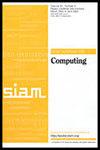突破2-逼近障碍的连通性增强:对斯坦纳树的约简
IF 1.6
3区 计算机科学
Q3 COMPUTER SCIENCE, THEORY & METHODS
引用次数: 1
摘要
生存性网络设计的基本目标是构建一个廉价的网络,该网络在给定的节点集之间保持连通性,尽管有一些边/节点出现故障。连接性增强问题可以说是这个领域中最基本的问题之一:给定一个(边)连接的图和一组额外的边(链接),选择一个最小基数的链接子集,这样添加到增加其边的连接性。直觉上,人们希望通过增加额外的边缘来增强现有网络的可靠性。对于这个np困难问题,最著名的近似因子是2,这可以通过多种方法来实现(第一个这样的结果是在[G。N. Frederickson和Jájá, SIAM J. Comput。, 10 (1981), pp 270-283]。它是已知的[E]。A. Dinitz, A. V. Karzanov和M. V. Lomonosov,《离散优化研究》,Nauka, Moscow, 1976, pp. 290-306],可以简化为奇数的树增强问题,也称为奇数的树增强问题,以及偶数的仙人掌增强问题。会议前本论文的版本[J]。Byrka, F. Grandoni和a . Jabal Ameli, STOC ' 20, ACM, New York, 2020, pp. 815-825],几个比2更好的近似算法已知,以最近的近似达到最终[F]。Grandoni, C. Kalaitzis和R. Zenklusen, STOC ' 18, ACM,纽约,1918,pp. 632-645]。然而,最著名的近似是2。在本文中,我们突破了2个近似障碍,因此,通过提出一个多项式时间近似。从技术的角度来看,我们的方法与以前的工作有很大的不同。特别是,优于2的近似算法要么利用贪婪式算法,要么基于四舍五入精心设计的lp。相反,我们使用了先前在参数化算法中使用的Steiner树问题的简化[Basavaraju等人,ICALP ' 14, Springer, Berlin, 2014, pp. 800-811]。这种减少并不是近似保留,并且使用Steiner树的当前最佳近似因子[Byrka et al., J. ACM, 60(2013), 6]作为黑盒将不足以改进2。为了实现后一个目标,我们“打开盒子”并利用斯坦纳树实例的特定属性。在我们看来,可生存网络设计的近似算法和steiner类型问题之间的这种联系是有趣的,并且可能导致该领域的其他结果。本文章由计算机程序翻译,如有差异,请以英文原文为准。
Breaching the 2-Approximation Barrier for Connectivity Augmentation: A Reduction to Steiner Tree
The basic goal of survivable network design is to build a cheap network that maintains the connectivity between given sets of nodes despite the failure of a few edges/nodes. The connectivity augmentation problem is arguably one of the most basic problems in this area: given a (-edge)-connected graph and a set of extra edges (links), select a minimum cardinality subset of links such that adding to increases its edge connectivity to . Intuitively, one wants to make an existing network more reliable by augmenting it with extra edges. The best known approximation factor for this NP-hard problem is 2, and this can be achieved with multiple approaches (the first such result is in [G. N. Frederickson and Jájá, SIAM J. Comput., 10 (1981), pp. 270–283]. It is known [E. A. Dinitz, A. V. Karzanov, and M. V. Lomonosov, Studies in Discrete Optimization, Nauka, Moscow, 1976, pp. 290–306] that can be reduced to the case , also known as the tree augmentation problem for odd , and to the case , also known as the cactus augmentation problem for even . Prior to the conference version of this paper [J. Byrka, F. Grandoni, and A. Jabal Ameli, STOC’20, ACM, New York, 2020, pp. 815–825], several better than 2 approximation algorithms were known for , culminating with a recent approximation [F. Grandoni, C. Kalaitzis, and R. Zenklusen, STOC’18, ACM, New York, 1918, pp. 632–645]. However, for the best known approximation was 2. In this paper we breach the 2 approximation barrier for , hence, for , by presenting a polynomial-time approximation. From a technical point of view, our approach deviates quite substantially from previous work. In particular, the better-than-2 approximation algorithms for either exploit greedy-style algorithms or are based on rounding carefully designed LPs. We instead use a reduction to the Steiner tree problem which was previously used in parameterized algorithms [Basavaraju et al., ICALP ’14, Springer, Berlin, 2014, pp. 800–811]. This reduction is not approximation preserving, and using the current best approximation factor for a Steiner tree [Byrka et al., J. ACM, 60 (2013), 6] as a black box would not be good enough to improve on 2. To achieve the latter goal, we “open the box” and exploit the specific properties of the instances of a Steiner tree arising from . In our opinion this connection between approximation algorithms for survivable network design and Steiner-type problems is interesting, and might lead to other results in the area.
求助全文
通过发布文献求助,成功后即可免费获取论文全文。
去求助
来源期刊

SIAM Journal on Computing
工程技术-计算机:理论方法
CiteScore
4.60
自引率
0.00%
发文量
68
审稿时长
6-12 weeks
期刊介绍:
The SIAM Journal on Computing aims to provide coverage of the most significant work going on in the mathematical and formal aspects of computer science and nonnumerical computing. Submissions must be clearly written and make a significant technical contribution. Topics include but are not limited to analysis and design of algorithms, algorithmic game theory, data structures, computational complexity, computational algebra, computational aspects of combinatorics and graph theory, computational biology, computational geometry, computational robotics, the mathematical aspects of programming languages, artificial intelligence, computational learning, databases, information retrieval, cryptography, networks, distributed computing, parallel algorithms, and computer architecture.
 求助内容:
求助内容: 应助结果提醒方式:
应助结果提醒方式:


